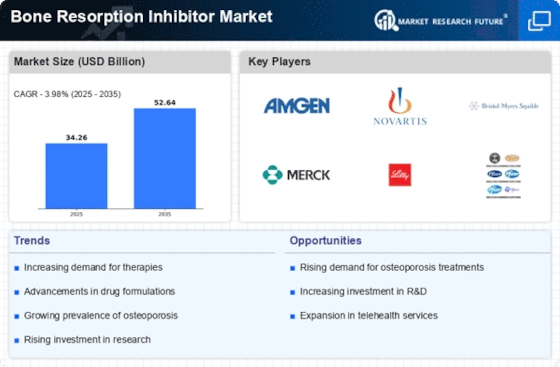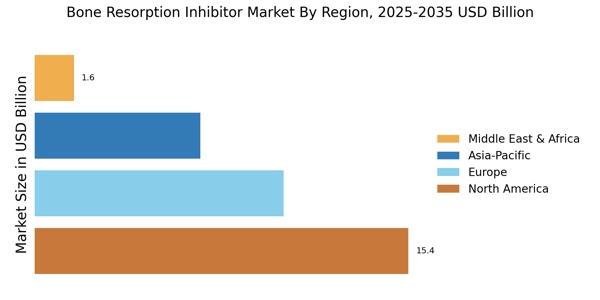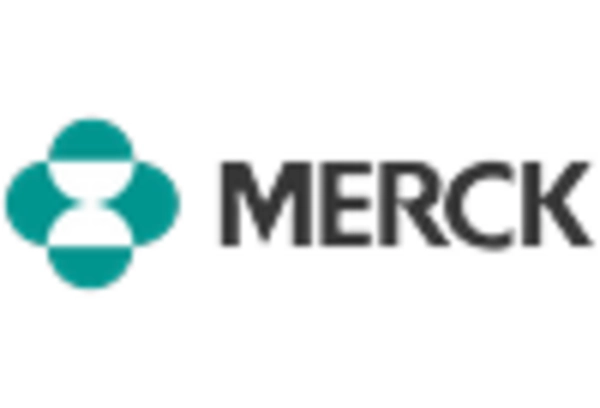Rising Awareness of Bone Health
Rising awareness of bone health among the population is a significant driver for the Bone Resorption Inhibitor Market. Educational campaigns and initiatives by healthcare organizations have led to increased knowledge regarding the importance of maintaining bone density and preventing bone-related diseases. This heightened awareness encourages individuals, especially those at risk, to seek preventive measures and treatments, including bone resorption inhibitors. As a result, the market is experiencing a shift towards proactive healthcare, with more patients opting for early intervention strategies. The emphasis on bone health is expected to continue influencing consumer behavior, thereby contributing to the growth of the Bone Resorption Inhibitor Market.
Increasing Incidence of Osteoporosis
The rising incidence of osteoporosis is a primary driver for the Bone Resorption Inhibitor Market. Osteoporosis affects millions worldwide, particularly among the elderly, leading to increased fractures and healthcare costs. According to recent estimates, approximately 200 million individuals suffer from osteoporosis, with a significant portion being women post-menopause. This growing prevalence necessitates effective treatment options, thereby propelling the demand for bone resorption inhibitors. As healthcare providers seek to mitigate the impact of this condition, the market for these inhibitors is expected to expand. The increasing awareness of osteoporosis and its consequences further fuels the need for innovative therapies, making it a critical factor in the Bone Resorption Inhibitor Market.
Regulatory Support for Innovative Therapies
Regulatory support for innovative therapies is emerging as a vital driver for the Bone Resorption Inhibitor Market. Regulatory agencies are increasingly recognizing the need for advanced treatment options to address bone health issues. This support facilitates faster approval processes for new drugs, encouraging pharmaceutical companies to invest in research and development. The introduction of expedited pathways for innovative therapies allows for quicker access to effective bone resorption inhibitors for patients. As regulatory frameworks evolve to support the development of novel treatments, the market is poised for growth. This trend indicates a favorable environment for the Bone Resorption Inhibitor Market, as it aligns with the ongoing demand for effective solutions in bone health management.
Technological Advancements in Drug Formulation
Technological advancements in drug formulation are significantly influencing the Bone Resorption Inhibitor Market. Innovations in drug delivery systems, such as sustained-release formulations and targeted therapies, enhance the efficacy of bone resorption inhibitors. These advancements not only improve patient compliance but also optimize therapeutic outcomes. For instance, the development of bisphosphonates and monoclonal antibodies has revolutionized treatment protocols, leading to a more effective management of bone-related disorders. The market is witnessing a surge in research and development activities aimed at creating novel formulations that can provide better results with fewer side effects. This trend is likely to drive growth in the Bone Resorption Inhibitor Market as pharmaceutical companies invest in cutting-edge technologies.
Aging Population and Increased Healthcare Expenditure
The aging population is a crucial driver for the Bone Resorption Inhibitor Market. As individuals age, the risk of developing bone-related conditions, such as osteoporosis, increases significantly. This demographic shift is accompanied by rising healthcare expenditure, as older adults require more medical attention and treatment options. According to projections, the elderly population is expected to double by 2050, leading to a corresponding increase in healthcare costs associated with bone health management. Consequently, pharmaceutical companies are focusing on developing effective bone resorption inhibitors to cater to this growing demographic. The intersection of an aging population and increased healthcare spending is likely to propel the Bone Resorption Inhibitor Market forward.


















Leave a Comment